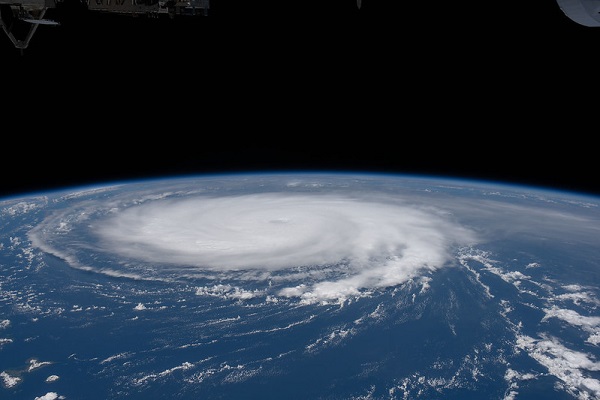
–>
October 6, 2022
Hurricane Ian was the only major tropical storm to strike the U.S. so far this season, but it was a powerful one — among the most powerful in U.S. history. Parts of southwest and central Florida suffered extensive damage and loss of life. And right on cue, climate alarmists are pointing to this as evidence of the “catastrophe” we face unless we eliminate fossil fuels.
‘); googletag.cmd.push(function () { googletag.display(‘div-gpt-ad-1609268089992-0’); }); }
For environmental radicals, Ian is proof that storms are getting stronger and more frequent and that seas are rising, but just shouting “climate change” doesn’t explain much about what is really happening — and it is useless as a tool for future policy-making.
To begin, hurricanes have not been striking the U.S. more often, nor are they more deadly. In the five-year period between 2017 and 2021, there were 16 U.S. landfalls, seven of them deemed “major hurricanes” by NOAA, with a total altogether of seven fatalities.
By comparison, in that same period, there were some 3,500 murders in Chicago alone and over 80,000 in the U.S. as a whole. Hurricanes are spectacular, and they cause a great deal of property damage, but they are not catastrophic in terms of loss of life and need not be catastrophic in terms of property damage. Even with Ian, the fourth strongest storm ever, the death toll stands at 68. That many are murdered in Chicago every month.
‘); googletag.cmd.push(function () { googletag.display(‘div-gpt-ad-1609270365559-0’); }); }
I don’t wish to minimize the suffering caused by Hurricane Ian. Along with the loss of life, tens of thousands are homeless, thousands of businesses have been damaged or destroyed, and hundreds of thousands lost power and clean water, at least for a time. The truth is that hurricanes have become far less costly in terms of human life, but a storm like Ian can be extremely costly to property in some localized areas.
Again the facts: Storms like Ian and Katrina are extremely powerful, and at the same time, seas have been slowly rising. But there have always been powerful hurricanes, and seas have risen less than a foot over the last 125 years. To be precise, the seas rose an estimated 6.7 inches in the 20th century, and a 2007 IPCC report predicted a rise of between 7 inches and 1.9 feet for the 21st century. That estimate has since been raised, by some at least, based on so-called scientific models, to an upper limit of 4.9 feet by 2100. But since sea levels have risen only 3 inches in the past 25 years, they have a long way to go to make 4.9 feet or even 1.9 feet by 2100.
The real reason behind increasing property damage is over-development on barrier islands and in low-lying coastal areas.
Even some mainstream news commentators are beginning to realize this. Just after Ian struck, AP reporters Ben Finley and Steve Helber published an analysis of “the risks and costs of living on barrier islands.” Finley and Helber quote a Tulane professor who states: “We can’t build back everything to what it was — we can’t afford that.”
Nor should we build back there.
Tropical storms have been striking North America for eons, with little damage or loss of life until humans began building in low-lying coastal areas. The devastating Galveston hurricane of September 1990 produced waves of 9 to 12 feet (even before “climate change”); the elevation of Galveston is 7 feet. The hurricane inundated nearly all of the city and killed some 8,000 residents of the area. At the time, Galveston was a boom-town based on its busy port trade. In just the decade before the storm, the population had grown from 31,000 to some 38,000. Thousands of homes had been built on land that was barely above sea level. It was inevitable that Galveston would be inundated sooner or later, but the building continued.
‘); googletag.cmd.push(function () { googletag.display(‘div-gpt-ad-1609268078422-0’); }); } if (publir_show_ads) { document.write(“
Galveston was not the first place where settlers had built on dangerous, low-lying areas. The very first English settlers made the same mistake.
When the British arrived at Roanoke Island in July 1584, only a few wretched inhabitants were living there and on the nearby barrier islands. Native Americans understood, as we do not, that sandy beaches are barren, windy, dangerous, low-lying places — useful only for breaking the force of storms and blocking storm surges. In fact, one theory regarding the disappearance of the Roanoke Colony is that the danger of hurricanes caused the British to relocate inland, where they joined well established Carolina Algonquian tribes. Any dwelling built on a coastal island was going to be swept away eventually, so why remain there?
Why, indeed? Yet today those barren islands are prime real estate, and millions of people live at or near sea level in homes and condos from Nantucket to South Florida. A currently listed home on Ocean Blvd. in Manalapan, Florida, with “150 feet of direct beachfront,” is listed for $45,000,000. The elevation of Manalapan, Florida is three feet.
Another example is Homestead, Florida, which Hurricane Andrew stuck in August 1992, destroying or severely damaging most of the city’s homes and businesses. Over the past 30 years, the city of Homestead has been rebuilt and now has a population of 81,000. Yet the elevation of Homestead is just 7 feet, similar to that of Galveston and hundreds of other coastal communities.
Indians living near America’s coasts had a much longer memory than modern-day builders. They located their large villages inland because they knew that it was dangerous to live on the coast at sea level — and that danger had nothing to do with climate change or rising seas. Why defy the odds and build where you will be swept away?
Liberal media are now claiming that Hurricane Ian was the product of climate change. It is true that seas are rising modestly, though I can find no compelling evidence of more frequent or more powerful storms. The most powerful hurricanes to strike the U.S. were the Labor Day hurricane of 1935 and, second, Hurricane Camille of 1969 — both long before academics and the media discovered “climate change.”
We are not facing catastrophe from rising seas or stronger storms, just a manageable problem. There have always been powerful hurricanes in the Gulf and Atlantic, and they have always caused damage and loss of life (much greater in the past than at present). Mankind cannot control the Earth’s climate, but we can decide where and how to build.
Curtailing our use of fossil fuels will not significantly alter the situation; it will only make life more expensive and unlivable for ordinary working Americans — and deprive them of the income they need to protect themselves from all sorts of natural events, including hurricanes, tornadoes, fires, and winter storms.
The simplest solution to the problem of storm damage is to avoid building, or rebuilding, in low-lying coastal areas. The Algonquian tribes were wiser than today’s coastal residents. If a property lies in a flood plain, why build there?
Jeffrey Folks is the author of many books and articles on American culture including Heartland of the Imagination (2011).

Image: NASA via Flickr, CC BY-NC 2.0.
<!– if(page_width_onload <= 479) { document.write("
“); googletag.cmd.push(function() { googletag.display(‘div-gpt-ad-1345489840937-4’); }); } –> If you experience technical problems, please write to helpdesk@americanthinker.com
FOLLOW US ON
<!–
–>
<!– _qoptions={ qacct:”p-9bKF-NgTuSFM6″ }; ![]() –> <!—-> <!– var addthis_share = { email_template: “new_template” } –>
–> <!—-> <!– var addthis_share = { email_template: “new_template” } –>




